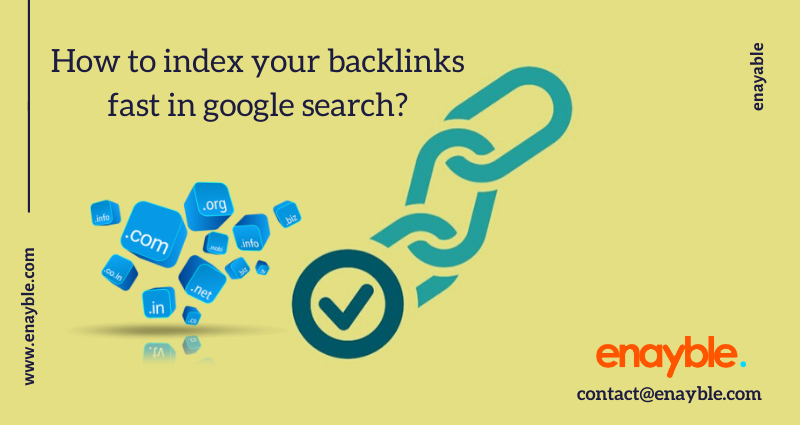How To Get Your Backlinks Indexed Fast in Google?

Google continuously updates its algorithms, and sometimes that changes the entire process of indexing. Since Internet Marketing is one of the most widely used marketing strategies, the internet is flooded with a massive count of websites. No matter how informative or entertaining a post is, there are high chances that people will never come across that post. The reason is improper search engine optimization and backlink indexing.
Getting backlinks indexed is a critical task in the digital marketing landscape. But there are some practical ways and tools that make the process more comfortable:
1. Waiting for a week or two
Backlinks generally take time to get indexed. A backlink can take up to a few seconds, to days to months to get indexed. It entirely depends on the quality of the backlink. High-quality backlinks get indexed easily and generate organic leads, but poor quality backlinks easily get lost in the search engine and there are chances that these backlinks will never be found. Waiting for a few days will actually help you to determine if the website is actually indexed or not. Organic and authentic content will get indexed quickly.
2. Ping your URLs
Pinging the URLs is essential for Google bots to notice them. Pinging is the process of sending an automatic notification to the search engine. When we build backlinks, most of the time, these links are low in quality. Out of these lower quality links, Google might come across less than 5 percent of them naturally. In other words, 95 percent of backlinks might get ignored by Google. Poorly linked posts and websites are basically hidden from the view.
Starting in 2010, it became quite popular to ping the backlinks using various tools available online, such as Pingomatic. When dealing with tons of backlinks a day, this is extremely time-consuming. Therefore, service providing companies have sprung up to make the workload less. It is also important to note that all pings do not always work. So it is essential to track Google crawls and the re-pings as required.
3. Create Web 2.0 links
Web 2.0 is publisher websites that allow users to create pages with personalized and unique URL. These websites include Social Bookmarking websites, Social Media Platforms, and Video Sharing platforms. Web 2.0 provides the page owners with sharing, grouping and other networking properties.
Earlier, creating a website required an enormous amount of HTML expertise and expensive website designing software. Today, 2.0 websites have made it easier for people to create webpages. One of the good reasons to get a web 2.0 site is to make its links backlinked. Modern-day web 2.0 sites allow their users to link their websites to their profiles and bios. Social media platforms are also a great choice to publish content.
Web 2.0 sites can also attract a high volume of traffic to your website. Each website has its set of users or a networking community. Creating a profile on these websites will help you to reach a broader set of audiences. Creating profiles on these sites to publish fresh, credible, factual and informative content will add value to the communities and generate traffic.
4. Build Relevant Links
Building relevant backlinks to your website will make it easier for Google to crawl through the website, making indexing assured and easy. When the search engines calculate the relevance of a site to a keywords, they mainly consider the number of quality inbound links to the website. The number of inbound links to that website.
When inbound links to a website come from other sites, and those websites have content relates to your website, these inbound links are considered to be more relevant to the website. If inbound links are considered more relevant to your website. If inbound links are found on sites with unrelated content, they are generally ignored. The higher the relevance, the greater their quality.
5. Track Results
Once all the hard work of creating content and backlinks is done, it’s time to sit back, relax and track the results of the process. Backlinks generally come from Web 2.0s, press releases, blog posts, articles, blog comments, etc. It is important to track every link that is coming to your website that is indexed. This does not include social media signals as they play a different role altogether.
Whenever a backlink is placed, it is vital to keep a track of the rankings before placing the backlink. This will allow us to see which links created the most positive or negative feedback. There are ranking trackers available online, but maintaining a log of the rankings before and after the links are posted is more beneficial.
Creating a list of keywords and which pages target them will also help determine the indexing of the backlinks. Some keywords do not do well for the posts and are irrelevant, this creates problems in relevancy, authenticity and indexing as well. Proper use of keywords is a must. Therefore, maintain a list of the most effective keywords. Putting relevant tags and keywords will make the indexing process faster and more efficient as the posts will be visible on results, generating more clicks on the backlinks.
Bottom Line
Search Engine Optimization is a dynamic landscape and it requires the presence of mind. The ever-changing trends might disrupt the protocol of your search engine optimization techniques. Ensuring that the backlinks are indexed sounds tedious and difficult, but if done correctly, indexing won’t invite hassle, and will only deliver positive results. Keeping a check on the fluctuating trends and acting accordingly will generate a good amount of traffic through backlinks which a website truly deserves.
